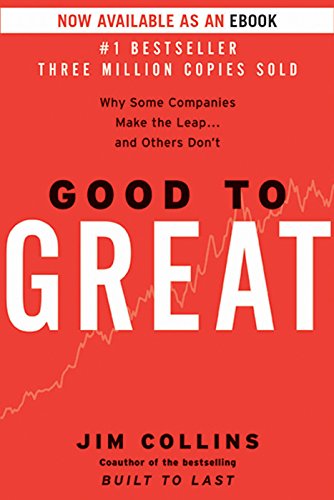

This article is an excerpt from the Shortform summary of "Good to Great" by Jim Collins. Shortform has the world's best summaries of books you should be reading.
Like this article? Sign up for a free trial here .
What are the keys to building a successful team? Why should building a great team be the first thing you do when you’re starting or revamping a business?
We’ll cover how to build a successful team and why it may be the most important thing you do for your company.
Build a Successful Team First
Contrary to their expectations, Collins et al. discovered that good-to-great leaders built successful teams before implementing any revolutionary reforms or setting off in a new direction.
The good-to-great executives concentrated on people and building a successful team first for three reasons:
- When good people come on board before a new direction is unveiled, they’re coming on board because of who else is on board. This means, if the company has to change direction down the road, these folks will stick with you—because it was never about the direction in the first place.
- With the right people, the need for motivation and management diminishes significantly—you’ve already determined your team is there for the right reasons and can handle whatever challenges arise.
- Great vision without great people is a nonstarter—even the most innovative executive needs a diversely talented team to help realize his or her goals.
Building a Successful Team: Wells Fargo
Wells Fargo’s rapid rise began in 1983, but the groundwork for its triumph was laid a decade earlier, when then-CEO Dick Cooley put together one of the most talented management teams in banking (the most talented, according to Warren Buffett).
Cooley predicted that banking would undergo massive changes in the coming decades, but he was also humble enough to know he couldn’t predict what those changes would be. So he instead decided to attract and retain as much talent as he could, even if positions had to be created for the new hires.
The strategy paid off when the major change—banking deregulation—came. While Wells Fargo’s sector as a whole trailed the general stock market by 59%, Wells Fargo boasted returns 3x the market.
Wells’s eye for talent was confirmed in the years after its triumph. Many of the executives that oversaw the bank’s navigation of banking deregulation went on to become CEOs of other major companies, including U.S. Bancorp, Household Finance, and Bank of America.
Team of Rivals vs. Thousand Helpers
How do you build a successful team? And what makes a great team great? Collins et al. found that the executive team at good-to-great companies (1) comprised leaders at or near Level 5 and (2) debated with each other vigorously over decisions.
Collins’s evidence suggests that a “team of rivals” approach—in which a leadership group is encouraged to argue enthusiastically with each other—is vital for taking a company from good to great. Although it sounds negative, this is actually a key to building great teams.
The key, however, is making sure the team eventually falls in line behind the final decision. The management team may disagree vehemently on almost everything in the runup to making a decision, but they must always come together to support whatever decision is reached.
The comparison companies, meanwhile, tended to subscribe to the “genius with a thousand helpers” principle. Rather than assemble a team of Level 5 executives with leeway to disagree, the comparison companies opted to enlist a bold leader who then cultivated a group of “good soldiers”—individuals whose capabilities were limited to helping the leader realize his or her vision instead of challenging and molding that vision.
NOT Building a Successful Team: Eckerd
Jack Eckerd, the brilliant and charismatic CEO of Eckerd Corporation, turned two pharmacies in Delaware into a thousand-store empire.
He was the initiator and executor of his company’s strategy; he neither developed an effective executive team nor groomed a successor.
His boundless personal energy eventually attracted him to politics, and he left Eckerd Corp. in the 70s to run for office and serve in the Ford Administration.
Shortly after his departure, the vacuum of talent in the management ranks became clear: Eckerd’s fortunes took a turn for the worse, and they were eventually acquired by J.C. Penney.
In Building a Successful Team, the Compensation System Doesn’t Matter
One might expect good-to-great companies to employ executive compensation schemes that favor stock options—how else are you going to incentivize executive performance and build a successful team?
But Collins found no correlation between compensation systems and performance: Some good-to-great CEOs were compensated with stock, others with cash. Collins also found a wide range among the good-to-great executives in terms of salary amounts and bonus incentives.
The only consistent finding Collins turned up was that good-to-great executives tended to be paid less than their comparison counterparts ten years after the transition point.
It all points back to building a successful team first. As long as the compensation package makes sense, the right executives will work tirelessly to make a company great. Level 5 leaders are driven not by financial incentives but personal principle.
Although data was less readily available for compensation for nonexecutive employees, what Collins et al. did find conforms with their topline finding—that getting the right people on the bus first mitigates the need to incentivize performance.
Disciplined, Not Destructive
Building a successful team sometimes means cutting workers, but indiscriminate layoffs can result in good people being jettisoned.
Good-to-great companies operate according to rigorous standards for performance. If a manager or employee isn’t meeting the standard, then that person either needs to shape up or be cut loose. Mass layoffs to preserve capital or restructure the business, however, are rarely found in good-to-great companies.
Despite good-to-great companies’ rigorous expectations, these companies relied far less on head-count layoffs than the comparison companies. Of the 11 good-to-great companies Collins studied, 6 initiated no layoffs at all from ten years before the transition point to 1998, and four others recorded only one or two. Among the comparison companies, layoffs were 5x more common.
Building a Successful Team: Wells Fargo
Wells Fargo acquired Crocker Bank in 1986 and, shortly thereafter, laid off 1,600 managers, including most of Crocker’s top executives, on one day.
At first glance, this seems like a classic case of one company buying another for scrap. But in reality, Wells Fargo was adhering to their exacting standard for their managers.
Crocker’s management was old school, enjoying a lavish executive dining room with expensive China and a gourmet chef. Wells Fargo’s management, on the contrary, conducted itself much more humbly, eating food prepared by a service that typically fed college students, for example.
Wells’s management knew the majority of Crocker managers wouldn’t fall in line with Wells’s culture, and so they made the move. And not only: Wells retained some Crocker managers that met their standard and fired their own managers, thereby proving that ability and performance, rather than tenure or position, was king.
Three Ways to Maintain Workforce Discipline
1. When in doubt, don’t hesitate to pass.
Good-to-great companies don’t compromise on whom they hire—they always want the best fit for an opening, and they’re willing to be patient until they find it. Don’t hire subpar people for the sake of growing quickly.
2. Know when a personnel change is essential, and act swiftly.
A failsafe sign that the wrong person is on the bus is when you have to start managing that person tightly.
Keeping that person on board just delays the inevitable; it frustrates that person’s team (because they have to pick up the slack), it frustrates you (because you’re constantly having to educate) and, in fact, it frustrates the person (because he or she might be able to flourish elsewhere if terminated).
One alternative to letting the person go is to find a different role for the person. If the person is willing and able, you might end up saving yourself the hassle of filling a hole. But if the person doesn’t rise to the occasion, the only solution might be to part ways. The key is to act, before the problem ramifies.
3. Save your best opportunities for your best people.
It’s common sense to put your best people on your biggest problems, because they’re the most likely to fix the problem. But to be great, you have to put your best people on your biggest opportunities, not your biggest problems.
For example, Philip Morris’s Joe Cullman transferred one of his most able managers from the company’s booming domestic division to its miniscule international business. The manager ran with it, turning Marlboro into the best-selling cigarette internationally three years before it took top honors in the U.S.
These strategies are key to building and maintaining a successful team.
Devotion Is the Payoff
Beyond the material benefits of building a successful team, there are interpersonal benefits as well: Good-to-great managers love what they do, love the companies for which they do it, and love the people with whom they get to do it.
Collins found that good-to-great leaders described their executive tenures as love affairs or the high points of their lives. They relished coming into work and sharing their careers—and lives—with their colleagues.
Philip Morris’s good-to-great executive team, for example, kept offices at the company even after their retirement, and, despite their disagreements, continued to come into work just to see each other.
Quiz: Building a Successful Team
- True or False: I should hire the best person available for an open position, even if I have reservations about that person.
- True or False: You know you have a great team when everyone always agrees with one another.
- True or False: Incentive-maximizing compensation schemes are insignificant to good-to-great leaders.
- True or False: If you have a great idea, retaining a great team can wait.
- True or False: When presented with talent, you should retain it, even if there’s no current need for that talent.
Answers:
- False. Good-to-great companies don’t compromise on hiring. If you have doubts, keep looking.
- False. Great teams debate passionately over decisions—though, once a decision is reached, they support that decision no matter what their original position.
- True. Collins found no correlation between stock-option-heavy compensation systems and executive performance.
- False. It’s more important to have the right people on the bus than a destination.
- True. Talented, capable, disciplined people will help your organization in unforeseen ways.
Top-Line Takeaways for Building a Successful Team
- Good-to-great companies recruit and secure top talent before embarking on any transformative changes.
- In the good-to-great companies, the management team was cast as a group of equals pushing toward a common goal. Comparison companies, meanwhile, typically followed the “genius with a thousand helpers” model—when a visionary leader surrounds him- or herself with people who can help realize that specific vision.
- Good-to-great executives will perform regardless of the specifics of the compensation system, as long as compensation is reasonable.
- Leaders of the good-to-great companies were disciplined in hiring and firing decisions, but they weren’t ruthless—they made people changes according to a rigorous standard and relied far less than their comparison-company peers on layoffs and restructurings.
- Good-to-great teams boast a comradeship that lasts well beyond their tenure with the company.
These strategies for building a successful team can take your company from good to great.
———End of Preview———

Like what you just read? Read the rest of the world's best summary of "Good to Great" at Shortform . Learn the book's critical concepts in 20 minutes or less .
Here's what you'll find in our full Good to Great summary :
- The 3 key attributes of Great companies
- Why it's better to focus on your one core strength than get spread thin
- How to build a virtuous cycle, or flywheel effect, in your business






